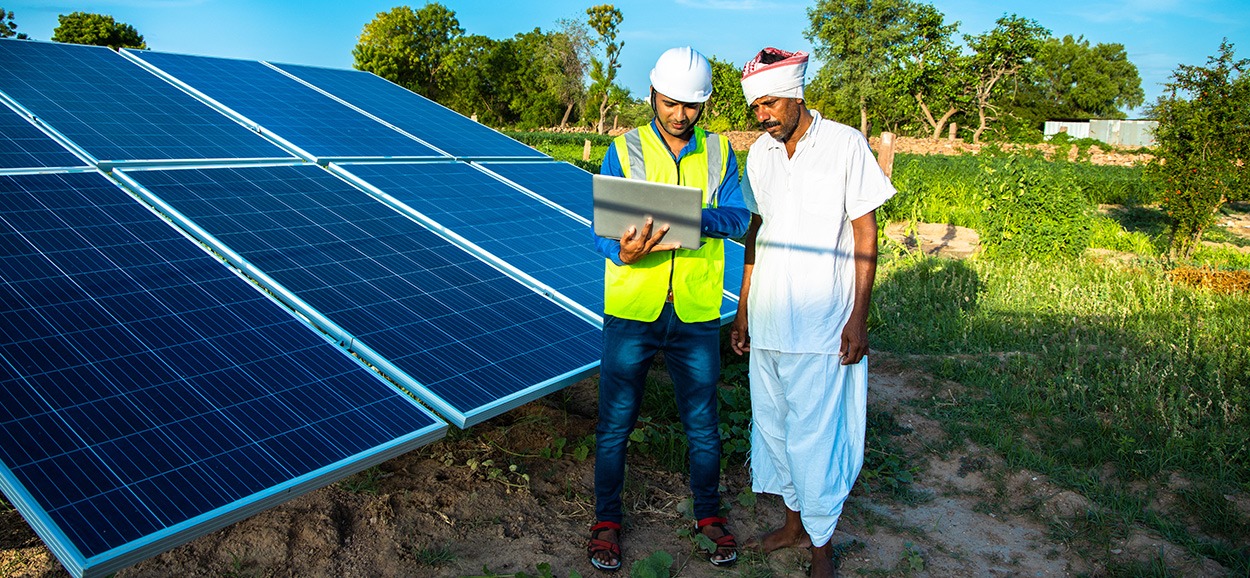What is Green solar energy ?
Green solar energy, also known as solar power or solar energy, refers to the use of sunlight to generate electricity or heat. It is a renewable energy source that does not produce greenhouse gas emissions or air pollution during operation, making it environmentally friendly.
Solar energy is harnessed through the use of solar panels, also called photovoltaic (PV) panels. These panels contain solar cells made of semiconducting materials, such as silicon, which absorb sunlight and convert it into electricity. When sunlight strikes the solar cells, the photons in the light excite the electrons in the semiconducting material, creating an electric current. This direct current (DC) is then converted into alternating current (AC) through an inverter, which can be used to power homes, businesses, or feed into the electric grid.
The benefits of green solar energy include:
- Renewable and abundant: The sun is an abundant source of energy, and solar power is inexhaustible as long as the sun continues to shine.
- Reduced greenhouse gas emissions: Solar energy production does not release greenhouse gases, helping to mitigate climate change and reduce air pollution.
- Cost-effective: The cost of solar panels and installations has decreased significantly over the years, making solar energy more affordable and accessible for homeowners and businesses.
- Energy independence: Solar power provides a decentralized energy source, allowing individuals and communities to generate their own electricity and reduce reliance on fossil fuels.
- Job creation: The growth of the solar industry has created numerous job opportunities in manufacturing, installation, maintenance, and research and development.
- Longevity and low maintenance: Solar panels have a long lifespan (typically 25 to 30 years) and require minimal maintenance, resulting in cost savings over their lifetime.
- Modular and scalable: Solar installations can range from small-scale residential systems to large-scale solar farms, making it a flexible and adaptable energy solution.
Despite its benefits, solar energy also faces some challenges. These include the intermittent nature of sunlight, which requires energy storage solutions for consistent power supply, as well as the need for large surface areas to install solar panels in utility-scale projects. However, advancements in battery storage technology and the increasing efficiency of solar panels are helping to address these challenges.
Overall, green solar energy is a key component of the transition to a sustainable and low-carbon energy system. By harnessing the power of the sun, we can reduce our reliance on fossil fuels, decrease greenhouse gas emissions, and create a cleaner and more sustainable future.
Why green solar energy is used?
Green solar energy is used for several reasons, primarily due to its numerous environmental, economic, and social benefits. Here are some key reasons why green solar energy is widely adopted:
- Environmental benefits: Solar energy is a clean and renewable energy source that does not produce greenhouse gas emissions or air pollutants during operation. By using solar power, we can reduce our reliance on fossil fuels, decrease carbon emissions, and mitigate climate change. Solar energy also helps to conserve natural resources by minimizing the need for extraction and consumption of finite resources like coal, oil, and gas.
- Renewable and abundant: Solar energy is derived from sunlight, which is an abundant and inexhaustible resource. As long as the sun continues to shine, solar energy will remain a viable and sustainable source of power. Unlike fossil fuels, which are finite and depletable, solar energy offers long-term energy security.
- Energy independence: Solar power provides a decentralized energy source, allowing individuals, businesses, and communities to generate their own electricity. This reduces dependence on centralized power grids and fossil fuel imports, promoting energy independence and resilience. Solar energy systems can be installed on rooftops, in remote areas, or in off-grid locations, enabling access to electricity in previously underserved regions.
- Cost savings: While the upfront costs of installing solar panels have historically been a barrier, the cost of solar energy has significantly declined in recent years. Improved technology, economies of scale, and government incentives have made solar power more affordable. Once installed, solar panels have minimal operating costs and can generate electricity for decades, resulting in long-term cost savings on electricity bills.
- Job creation and economic growth: The transition to solar energy has created a substantial number of jobs across the entire value chain, from manufacturing and installation to maintenance and research. The solar industry provides employment opportunities in local communities, stimulates economic growth, and fosters innovation in renewable energy technologies.
- Grid stability and resilience: Distributed solar energy systems can enhance the stability and resilience of electricity grids. By generating power closer to the point of consumption, solar energy can reduce transmission losses and strain on the grid. Additionally, incorporating solar power into a diversified energy mix can enhance grid reliability, especially when coupled with energy storage technologies.
- Long-term sustainability: Solar panels have a long lifespan (typically 25 to 30 years) and require minimal maintenance. They are composed of recyclable materials, and their components can be repurposed or recycled at the end of their life, contributing to a circular economy and minimizing waste.
By harnessing the power of sunlight, green solar energy provides a sustainable and environmentally friendly alternative to conventional fossil fuel-based energy sources. It helps combat climate change, promotes energy security, fosters economic development, and creates a more sustainable future for generations to come.
Where Green Solar energy is used ?
Green solar energy is used in various locations and applications around the world. Here are some common areas where green solar energy is utilized:
- Residential Buildings: Many homeowners install solar panels on their rooftops to generate electricity for their homes. Residential solar systems can offset electricity consumption, lower energy bills, and provide a sustainable source of power for households.
- Commercial Buildings: Solar energy is increasingly deployed in commercial and industrial settings, including office buildings, warehouses, factories, and shopping malls. Solar installations on commercial buildings help reduce operational costs, demonstrate corporate sustainability, and contribute to carbon footprint reduction goals.
- Utility-Scale Solar Farms: Large-scale solar power plants, often referred to as solar farms or solar parks, are developed in sunny regions with ample land availability. These utility-scale installations consist of multiple solar panels or solar arrays and feed electricity into the grid to supply power to communities and industries.
- Remote Areas and Off-Grid Locations: Solar energy is particularly useful in remote areas or off-grid locations where connecting to a centralized power grid may be challenging or costly. Solar panels can provide electricity to power homes, schools, healthcare facilities, and other essential services in these regions, improving living conditions and enabling economic development.
- Developing Countries: Solar energy plays a vital role in providing access to electricity in developing countries, where grid infrastructure may be limited. Off-grid solar systems, such as solar lanterns and microgrids, are used to power households, schools, and community centers, addressing energy poverty and supporting sustainable development.
- Transportation: Solar energy is being integrated into various modes of transportation. Solar panels are used in electric vehicles (EVs) to provide supplemental power or recharge auxiliary systems. Solar-powered charging stations are also being established to facilitate the charging of EVs with clean energy.
- Water and Space Heating: Solar thermal systems, which use solar energy to heat water or air, are widely employed for domestic hot water heating, swimming pools, and space heating in buildings. Solar thermal collectors capture the sun’s heat and transfer it to a fluid, which can then be used for heating purposes.
It’s important to note that the adoption of green solar energy is not limited to these areas alone. Solar power has the potential to be implemented in various contexts, both small-scale and large-scale, wherever there is access to sunlight and a need for clean and sustainable energy.






